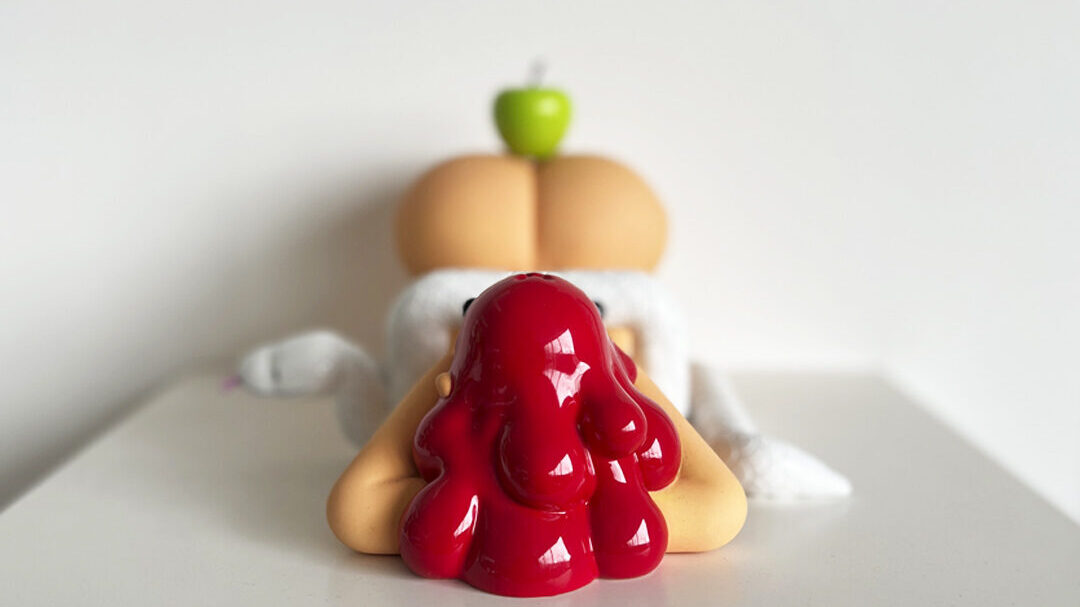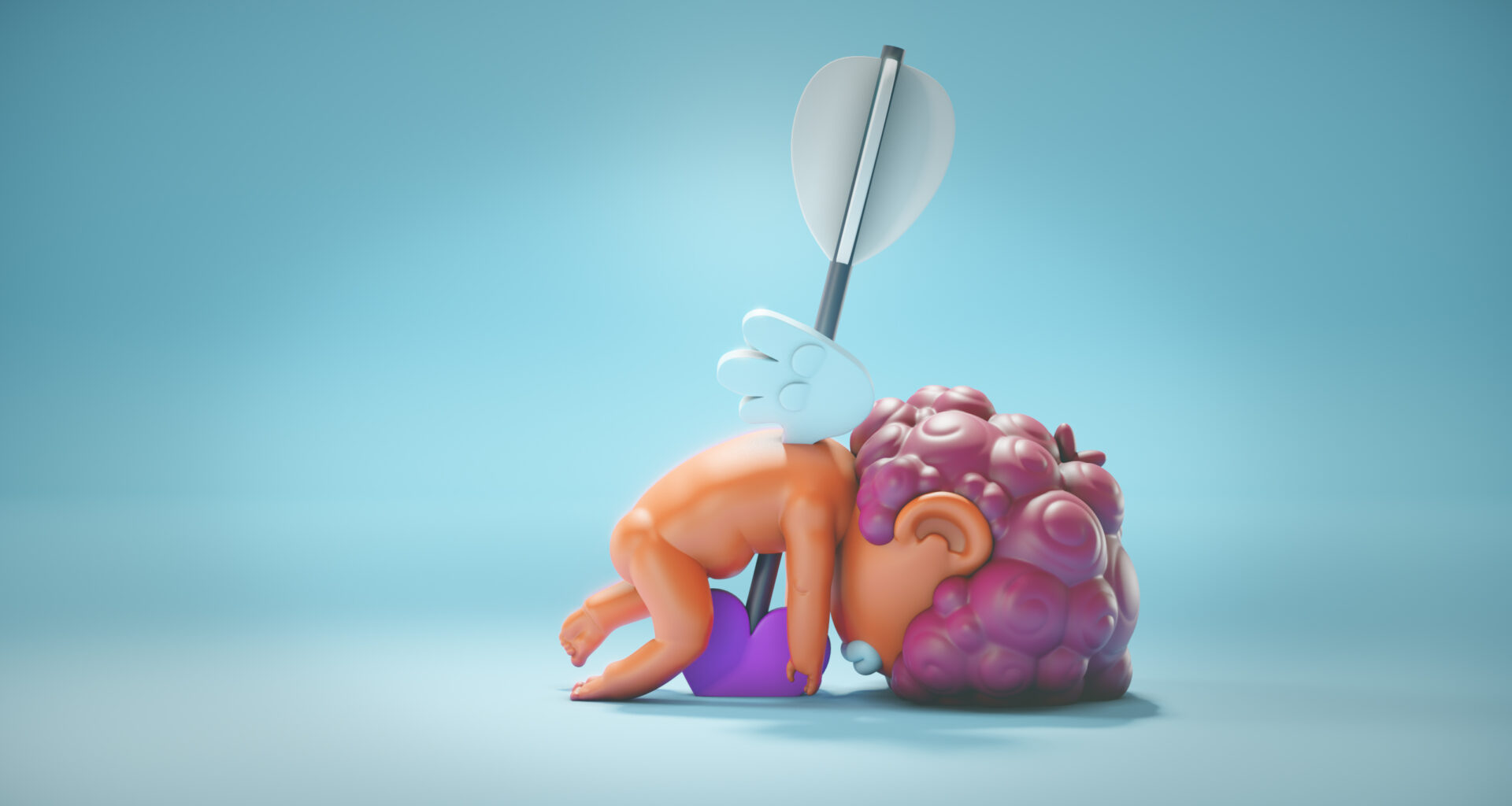Linus Cheng (Australia, 1996) graduated in Art and Design from UNSW with a Bachelor’s degree in Media Arts. His works oscillate between emotion and action, mastering various disciplines such as conceptual art, character design, sculpture, or illustration. He possesses versatility and the ability to approach artistic creation from multiple perspectives. Cheng’s works are emotional, challenging, and questioning, characterized by striking colors and vibrant shapes, a clear example being his sculpture Lilith.

1. What are your origins in the world of art?
One of my earliest memories is drawing a few pages of a dragon befriending a little girl in a tree house. I may have been around five years old. I stapled these pages together to form a picture book of sorts and presented it to my teacher as the other kids played with toys around the classroom. She was so impressed, she later took me to the staff room to showcase my book to the other teachers and principal during lunchtime. I think maybe in that moment I became an artist, realizing I desired to create more than consume. Drawing and storytelling then transitioned over the years from play to hobby, to passion, to practice, to profession. I think we all begin somewhat in the world of art, the world of creation and curiosity, and then we decide to stay in it. To not stop creating and storytelling.
2. Who are your references or influences?
This question floods my mind with an ocean of images I’ve seen over the years. There’s so much amazing work out there in every field, from animation, design, fashion, illustration, photography, sculpture, architecture, and everything in between and beyond. It’s impossible to name everyone who’s influenced my creative eye let alone know the names behind all the works I’ve admired over the years. I would say my influences aren’t consistent and are too vast to pinpoint, but if I had to name names, these are some people who come to mind.
Genndy Tartakovsky, for his hand in creating such powerful graphical compositions in iconic animated shows. Pascal Campion, for his ability to capture life and love in his glowing pieces. Ashley Wood, for his marriage of comic and contemporary style. And Ichijo Hikaru, for her radiant and boldly fun graphic design.

3. What was the collaboration process with 6Forest Studio to bring this piece to life?
Well, 6ForestStudio reached out to me with a gracious opportunity to collaborate with them. Hearing the brief, they wanted a line of pieces with the suggested theme of Angels and Demons. The opportunity to make sculptures with the support of 6Forest was not one I’d dream of passing. With that they let me get to work and I drew up some concepts, which they supported and reviewed with structural concerns in mind. I then created diagrams of the characters which they helped translate into 3D designs. They let me review the models to make notes and adjustments until I was happy with the interpretation. Lastly, they would update me on the manufacturing process and send images of prototypes. And then it ended up at my doorstep.
4. Do you have any anecdotes/setbacks/challenges you encountered during Lilith’s creation process?
The Lilith design and concept came about quite quickly and smoothly. From my initial sketch which was her side view, I was instantly happy with its geometric flow and seductive snake shape. It read well as a graphic element, but I think the challenges became clearer when translating it into 3D. It took a bit of tweaking to capture the strong shape forms and curves in the perspective drawings, this was especially so for her hair while softening the rigidness of the 2D design structure. The 2D design read as bold and flat, whereas the 3D design aimed to add flow and weight, and bridging those two things took some creative problem-solving. Thankfully with the help and the great work of 6Forest, we were able to bring her to life, successfully capturing her strong shape flow, and graceful curves.

5. What was your reaction when you had the first figure of the line in your hands?
This is heavy. It took me a bit to process what I was holding. This little sketch in my book and design I’d worked on and seen on my laptop screen time and time again, was now weight in my hand. Something I could pick up and move, walk around, look at from every possible angle, a physical embodiment of the creative work that went into creating Lilith. It was Lilith. I think my reaction was honestly dull because I was overwhelmed in trying to believe it was real and in my hands.
6. What messages or feelings do you hope to convey to the viewers and collectors of your work?
I hope my work adds positive value to people. I hope the work breathes life into the space it occupies. It feels light, friendly, fun, inspiring, and charming, and elevates whatever state you’re in. Each work embodies a few vague messages and themes I wish to play around with, so I hope viewers can also find value in those messages or create their meanings to the pieces. Overall I want my pieces to brighten up the space they’re in and push the occupants of that space to be more present. If you can also learn something from the pieces, that’s a bonus.

7. Do you use Artificial Intelligence as a tool in the creation process of your pieces? What is your stance on it?
No. But in some ways I act with the same mechanics as AI, I gather a bunch of references and then generate ideas. That simple mechanic is also all that I am as an artist. My creative eye in deciding what to reference and draw inspiration from, my hand at crafting all that I’ve seen and learned, and deciding which directions and decisions I want to make for the piece. All these micro-actions hold a representation of what I see, what I think, and who I am, and I think that’s how my soul gets placed into the piece. This means that the more creative decisions I make in a piece the more of my soul I put in it. So If I outsource a creative decision, it robs me of an opportunity to put more soul into the piece. That is why handwritten letters feel richer than automated emails. But we still use these tools because they make making decisions easier and faster, which is okay but comes at a cost. At the end of the day, I think people want to connect with people, and everyone has a subconscious eye for what feels genuine and meaningful, and they will gravitate toward those things.
I’m probably not well educated in the ethics and practices of AI, but respect for source material should always be addressed. My amateur opinion is that it is a powerful tool to help aid creativity, not replace it. I would compare it to the shift from oil painting to digital painting, and how these technologies allowed us to copy brush strokes and apply premade effects. The tools may change, the material may change, and the process may change, but the purpose of art will stay the same. To me, it will always be about sharing and exploring perspectives. And to use AI is to outsource your perspective, the most valuable thing in your art, it would be to cut yourself out of the work. So I think it wise to use it in aid of materializing your perspective, not in creating the perspective itself.
8. Every artist has a unique style. How do you think your signature is reflected in this Art Toy?
I tend to gravitate towards bold graphic designs, Lilith being no exception to this. I like strong silhouettes and playful shapes, and Lilith embodies that.
9. What does Art Toy mean to you as a medium of artistic expression and how do you think it relates to other art forms?
I think Art Toys are more character-centered, embodying more of a personality than other mediums, giving the pieces a more independent life. Art Toys feel more playful and youthful because regardless of their gallery context, they identify as Toys. Toys are a symbol of play, fun, imagination, creativity, innocence, joy, and tones that balance out any jarring seriousness associated with its contemporary context. It’s in the in-between of high art seriousness and creative play that Art Toys thrive as a unique art form. As an artist, Art Toys allow me to appreciate art in all its maturity, as well as tap into the roots of my creativity. Toys may maybe one of the first true examples of art that we expose ourselves to as kids. As a kid, we see something of aesthetic value that elicits an emotional response in us, and then we use it to open up new perspectives of the world around us through play. I think Art Toys are pretty special because they embody the origins of art, perspective, and play.

10. Finally, is there anything else you would like to share with the followers and art enthusiasts who follow your work and that of 6Forest Studio?
Well first off, 6 Forest Studio has amazing taste. Secondly, I hope my work offers some enthusiasm in their day, and reminds them to play and appreciate the things around them. Lastly, don’t forget to create, creativity isn’t a talent you are born with but a muscle you can exercise. No matter how big or small, make something, and express yourself, it’s how we build stronger relationships with ourselves and others.



I relish, lead to I discovered just what
I used to be having a look for. You’ve ended my 4 day
lengthy hunt! God Bless you man. Have a nice day. Bye
thanks! bless to you too!